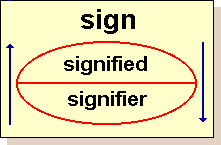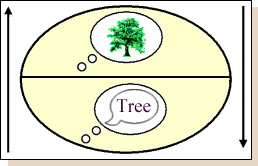[Week 8: Oct 21] B1. Semiotic approach
 0. Content analysis
0. Content analysis0.1. The imbalance between the represenation of women and men in media
0.2. Examples:
-Over-representation of women's sexuality in entertainment news
-Under-representation of women as professionals in advertisement
0.3. Weakness
-Over-emphasis on proportion rather than relationships
-Making comparison between reality and media (but media is more and more irrelevant to reality).
1. Why Semiotics?
1.1. A modern cultural transformation
1.2. Discontiunity of history and tradition
1.3. Mass media: a machine for producing signs
1.4. Postmodernism: Symbolic pastiche and collage
Example: Andy Warhol
1.5. Example: From Rococo to "Lolita"
1.6. The patterned relationship between signs
 2. Ferdinand de Saussure: structualist linguistics
2. Ferdinand de Saussure: structualist linguistics2.1. Sign: Signifier / Signified
-'signifier' (能指或符號具) : the form which the sign takes;
-'signified'(所指或符號義) : the concept it represents.
-Signification (指涉過程或意義化): The relationship between signifier and signified
2.2. The relationship between signifier and signified is arbitrary
2.3. The value or meaning of a sign depends on its relationship with other sign (signifier/ signified)
 2.4. Example: Traffic light (Red, Yellow and Green)
2.4. Example: Traffic light (Red, Yellow and Green)

3. Denotation and connotation
3.1. Connotation (外延): The set of a sign's possible signifieds.
3.2. Denotation(內涵): The most stable and apparetnly verifiable of its connotations.
3.3. Example: The incident of June 4
References: The controversy over the incident of June 4
 3.3. Example: Body-trimming
3.3. Example: Body-trimmingSignifier A: The body shape in the photo
Signified A: Thin
Signifier B: Thin
Signified B1: Self-confidence
or
Signified B2: Healthy
or
Signified B3: Sexy
... ...
5. Metaphor(隱喻) and metonym(轉喻)
5.1. Metaphor is an implicit or explicit comparison between signs. -Example: “Gun” and “Man”(and phallus)
5.2. Metonym is a sign associated with another of which it signifies either a part, the whole, one of its functions or attributes, or a related concept.
-Example: “Gun” and ”power”


6. Code
-A conventional system which enables signification
-It is a relatively stable relationship between signs
6.1. Encoding
6.2. Decoding
7. Representation (呈現) and stereotype (核板印象)
7.1. Representation: The way or form of how groups or possible identities are represented in the media.

Who is girl? Who is boy? How do you identify their gender identity?
7.2. Stereotype:
Figures who represent a concentration of attributes considered ideal or contemptible.
Example: "New immigrant", "mainlander", ... ...
8. Myth (Roland Barthes)

Myth: Naturalized codings of social meanings and values
8.1. Myth: Multiple orders of signification:
-The first order of signification
-The second order of signification
... ...
8.2. Myth: Metaphoric and metonymic transformation
-Signs are interrelated with one another in metaphorical and metonymical way as social convention.
Myth of masculinity: "Man"<-->"Gun"<-->"Power"
9. Ideology and Hegemony (霸權)
-Ideology: naturalized myth and its naturalizing process
-Hegemony: the social process of consensus in which power relations follow the cultural leadership of a dominant group
10. Example I: Luxury motor and woman's body

10.0. Question: How does woman's body come to be symbolically associated with luxury motor?
Some photos of women and luxury motor
10.1. Analysis of the orders of signification
10.2. Analysis of metaphoric and metonymic relationship
Metaphor: Women's body-->Men's sex object
Metonym: Sex object-->sexual desire
Metaphor: Sexual desire-->materialistic desire
Metonym: Materialistic desire-->luxury motor
10.3. Stereotype: A pretty woman is something like a motor rather than a good driver or car owner.
10.3. The Myth of "beauty and motor" perpetuated by men's desire and fantasy
10.4. Hegemony of commodity culture, sexuality and patriarchy
11. Example II: Woman and printer
Semiotics for beginners
0 Comments:
Post a Comment
<< Home